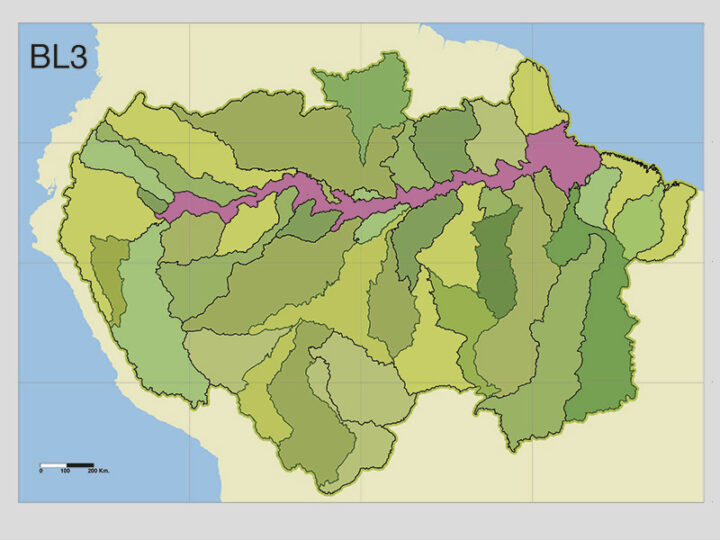The Amazon River, from its headwaters in the Andes to its mouth in the Atlantic, runs at least 5,000 kilometers. Indigenous people have known for centuries about local fish migrations, and this information has been crucial in supporting their livelihoods. Through the region’s colonization, western society learned and incorporated this knowledge into its knowledge of the area’s natural history. With the rise of commercial fisheries in the latter half of the 20th century, we were able to learn that some fish migrate the entire course of the river. How has current research continued to explore these migrations? A research team, including Amazon Waters Initiative partners, is trying out different techniques to measure these trips.
One technique these researchers are using to determine where fish have been is otolith microchemistry. Otoliths are ear stones: small calciferous bones in a fish ear that grow in rings according to a fish’s age or size, much like tree trunk rings. This means that each ring contains information about what the fish’s surrounding looked like while it was growing. Using lasers, scientists can measure the ratio of strontium isotopes (-87, -86) in each ring and match it to the ratio of the waters where fish have been at a particular size or age.
Researchers used this technique to track where two important goliath catfish, Brachyplatystoma rousseauxii (dourada) and Brachyplatystoma platynemum (babão), migrate. They found individual dourada otolith signatures that showed a migratory round trip of more than 8000 kilometers, taking fish away from the basin they were hatched and back to it to spawn (Duponchelle et al., 2016)! Based on this information, it was assumed that all goliath catfish had similar migration routes. However, in 2018, researchers published an article showing much shorter migrations for the babão (Hauser et al. 2019). They also found that dams clearly get in the way of their natural migrations, as fish caught before the construction of Madeira dams in the Upper Madeira river had strontium signatures that supported migration down river, while fish caught after the dams were built did not (Hauser 2018).

Migration of the dourada catfish, from The Dourada Catfish: An Amazonian traveler with no borders.
Another technique these researchers have used is identifying fish larvae genetically to determine their overall migrations (Garcia-Davila et al., 2015; Mariac et al., 2018). Using nets made to catch plankton, researchers can harvest fish larvae and then quickly sequence a mitochondrial gene, cytochrome c oxidase subunit I (COI). By looking at how similar these sequences are to those obtained from adult fish, they can determine species’ spawning areas. We now know that two commercially important species, Brachyplatystoma filamentosum and Pimelodus blochii, breed during high water season, while other commercially important species, such as B. rousseauxii and B. platynemum, among others, breed during low water season in the Peruvian Amazon around Iquitos (Garcia-Davila et al., 2015). Finally, a new metabarcoding technique they developed recently now allows for the massive identification and relative quantification of fish species in plankton samples (Mariac et al., 2018).
Finally, researchers are formally including and recognizing the power of the Amazonian people to learn more about where fish are at different stages of their lives. Under the Citizen Science for the Amazon project, the Cornell Laboratory of Ornithology, WCS, and other partners created an Android app called Ictio to record the fish they see while fishing or at the market. Users can track their own fish capture, a useful feature for fishers who depend on migratory fish for their livelihoods and food security. Moreover, this crowdsourced data contributes to answering an important scientific question at a large scale: where are migratory fish in the Amazon throughout time?
These answers are important not only for inhabitants of the Amazon, who depend on fish and aquatic resources, but also for scientists and conservationists who want to help manage these resources in a more sustainable way. Fish are an important food source in the Amazon basin, where in some places people eat as much as 1 kilogram of fish a day. With more information about how fish migrate, humans can make smarter decisions about how to develop infrastructure and manage and conserve freshwater ecosystems and their fish across political boundaries.
References
Barthem et al., 2017. Goliath catfish spawning in the far western Amazon confirmed by the distribution of mature adults, driving larvae and migrating juveniles. Scientific Reports 7:41784. doi: 10.1038/srep41784
Duponchelle et al., 2016. Trans-Amazonian natal homing in giant catfish. Journal of Applied Ecology. doi: 10.1111/1365-2664.12665
Garcia-Davila et al., 2015. Using barcoding of larvae for investigating the breeding seasons of pimelodid catfishes from the Maranon, Napo and Ucayali rivers in the Peruvian Amazon. Applied Ichthyology 31(Suppl. 4): 40-51. doi: 10.1111/jai.12987
Goulding et al., 2018. Ecosystem-based management of Amazon fisheries and wetlands. Fish and Fisheries 1:1-21. doi: 10.1111/faf.12328
Hauser et al., 2019. Shedding light on the migratory powers of Amazonian goliath catfish, Brachyplatystoma platynemum, using otolith 87Sr/86Sr analyses. Aquatic Conserv.: Mar Freshw Ecosyst. 1:1-12. doi: 10.1002/aqc.3046
Mariac, et al.,2018. Metabarcoding by capture using a single COI probe (MCSP) to identify and quantify fish species in ichthyoplankton swarms. PLoS ONE, 13, e0202976.
Written by Natalia Piland.


